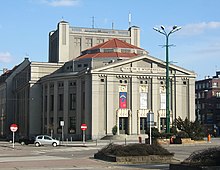Silesian Theater
The Silesian Theater ( Teatr Śląski im. Stanisława Wyspiańskiego ) is the city theater, one of the main attractions of the city of Katowice in Poland , as well as the largest theater and one of the most important cultural institutions in the region. It occupies a central place in the middle of Katowice city center on the Ring.
history
Katowice is a young city that developed as a result of industrialization and received city rights in 1865 . In view of the increasing importance and population growth of the city, there were early attempts to build a city theater. A support association was established that collected donations for the construction. As early as the spring of 1904, the city council unanimously passed the building decision based on a draft by the Cologne architect Carl Moritz , who already had experience in theater construction - provided that the Prussian state would make a contribution of 200,000 marks to the construction costs estimated at 630,000 marks . In 1905 construction work began. The ring or the former Friedrichsplatz was chosen as the building site and the old, simple brick town hall was torn down for the new building. From a structural point of view, the theater can be assigned to neoclassicism , with strong echoes of classical modernism , but also elements of Art Nouveau . At that time Kattowitz had around 35,000 inhabitants, Carl Moritz, on the other hand, created a disproportionately large theater with 410 seats, which would have fit in a big city with its cultural offerings, its architecture and its impressive size.
On October 2, 1907, the city theater was officially opened, also known as the German Theater . In his opening speech, Lord Mayor Alexander Pohlmann said that the city theater should be a proud and invincible bulwark against the hostile Polish way of life . This chauvinistic phrase expressed the purpose of this building in an exaggerated way. As the stone banner "Deutschem Wort und Deutscher Art" announced on the gable, the theater should on the one hand promote German cultural life in the entire region and promote the German language, on the other hand it should also be a symbol of the new, German-influenced city. In fact, Katowice had a clear German majority, but in the rural area, the situation was different.
With this city theater, in which many well-known actors appeared and others began their careers, Katowice became the cultural metropolis of the Upper Silesian industrial area . When Katowice fell to Poland in 1922, the theater was renamed the Polish Theater , but the minority agreements obliged Poland to maintain the cultural life of the Germans, which is why a German theater community continued to exist, which was played by German theaters from Upper Silesia, but also from other parts of Germany . On the other hand, as in German times, but this time the other way around, the theater was to carry out polonization measures. The old German inscription was removed, as were the two monumental Art Nouveau reliefs on the sides of the gable, which showed scenes from the Nibelungen saga, in the 1930s . In 1936 the theater was named after the Polish playwright and painter Stanisław Wyspiańskis , who was also installed over the gable after the Second World War , and it was the scene of numerous opera performances. During the German occupation in World War II, a plaque with the old inscription "Deutschem Wort - Deutscher Art" was attached to the theater, which was supposed to underpin the racist ideologies of the National Socialists .
In the post-war period and in communist Poland, the remaining architectural decorations of the theater (including the portals) disappeared and the facade was plastered in one color. In 2000, renovation work was completed which restored the old plastering and the portals, of which remains could still be used. Furthermore, three reliefs of dance, music and literature adorn the facade of the theater.
More recently, in addition to theatrical performances, theater exhibitions, musical performances, and literary meetings have also been held. In September 1996, for example, the “ Günter Grass Days” took place in the theater , in which numerous well-known translators of Polish and German literature took part.
Web links
- Theater website (Polish)
- Newspaper article about the renovation work (Polish)
Individual evidence
- ^ Deutsche Bauzeitung , Volume 38, 1904, No. 24 (from March 23, 1904), p. 148.
Coordinates: 50 ° 15 ′ 34.4 " N , 19 ° 1 ′ 21.2" E




